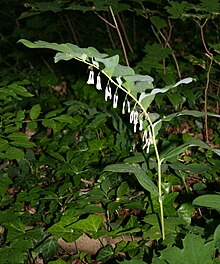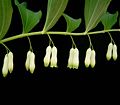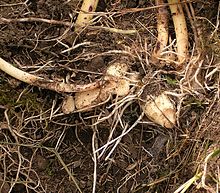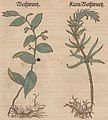Multi-flowered Weisswurz
| Multi-flowered Weisswurz | ||||||||||||
|---|---|---|---|---|---|---|---|---|---|---|---|---|

Multi-flowered Weisswurz ( Polygonatum multiflorum ) |
||||||||||||
| Systematics | ||||||||||||
|
||||||||||||
| Scientific name | ||||||||||||
| Polygonatum multiflorum | ||||||||||||
| ( L. ) All. |
The multi-flowered white root ( Polygonatum multiflorum ), also known as the multi-flowered Solomon's seal , forest white root or forest Solomon's seal, is a species of plant that belongs to the asparagus family (Asparagaceae). Colloquially it is often only called "Solomon's Seal", which is unfavorable because it has the same name as the similar but much rarer Real Solomon's Seal .
description
The multi-flowered white root grows as a deciduous, perennial herbaceous plant and reaches heights of 30 to 60 (100) centimeters. Your upright, bent stalk has a round or blunt-edged cross-section.
This geophyte forms a rhizome as a permanent organ. The conspicuous, white rhizome (hence the name "Weißwurz") has a diameter of about 5 to 9 mm. It is knotty thickened (Greek poly for "much" and gony for "knot"), the knots each corresponding to an annual increase. They arise as lateral branches from the axilla of scale-shaped lower leaves, while the tip of the rhizome extends into the upright flower stem. The rhizome thus represents a sympodium . Up to 17 annual periods were counted in a row. The disc-shaped depressions on the top of the nodes are the scarring points of the flower sprouts. With the numerous vascular scars, the knots are reminiscent of a seal (hence the name "Solomon's Seal").
The alternate and two lines arranged leaves are stalked sitting or short and simple. The egg-shaped to oblong-elliptical leaf blade is narrowed at the base, 5 to 17 cm long and 2 to 7.5 cm wide. The upper side of the leaf is dark green and the underside of the leaf is frosted gray-green.
In the leaf axils there are racemose inflorescences , each containing three to five flowers. The hairless stems of the inflorescences are 10 to 12 mm and those of the flowers are 6 to 7 mm long. The pendulous and odorless flowers are threefold. The six identical bloom cladding sheets ( perigon ) are fused tubular, white with green tips and 11 to 15 (to 18) mm long. The stamens are hairy sparsely downy. The flowering period extends from May to June.
The dark blue to black berries are frosted and about 7 to 9 mm in diameter. The fruit ripens between August and September.
The number of chromosomes is 2n = 18, 20, 28 or 30.
- photos
Distribution and ecology
The multi-flowered white root is widespread in the temperate climates of Eurasia and North America .
The species is found quite often in herbaceous beech, oak and mixed coniferous forest communities. It loves loose, base-rich, often calcareous clay soils in a shady location. According to Ellenberg , it is intermediate-continental, indicating a freshness indicator, moderately nitrogenous locations and a character type of the noble deciduous mixed forests (plant-sociological order Fagetalia sylvaticae ). In the Allgäu Alps, it rises in the Tyrolean part near Elbigenalp to over 1000 meters above sea level.
The many-flowered Weisswurz is a geophyte . The flowers are homogamous "bluebells with sticky pollen". The nectar can only be reached by long-nosed bumblebees or butterflies , which, however, rarely visit the flowers. Self-pollination is common. The fruits are poisonous berries that taste disgustingly sweet. It is digestive spread instead. Vegetative reproduction occurs through branching of the rhizome.
The multi-flowered white root is the host plant of the Solomon's seal sawfly , the larvae of which can devour the leaves, flowers and fruiting plants of the plant in spring.
Toxicity and Use
All parts of the plant are poisonous, especially the berries; they contain saponins and other toxins. Older data on the occurrence of cardiac glycosides that act on the heart have not been confirmed.
It contains steroidal saponins and flavonoids. They are used for wound healing, especially due to their antibacterial effect. The drug is also used for its expectorant effects.
mythology
In the past, the species of the genus Polygonatum were said to have mysterious powers: According to the doctrine of signatures , they were considered a remedy for corns. According to the legend, the rhizome is the mysterious "springwort" that only the woodpecker knows how to find, and when it is in possession of it, locked doors can be opened by magic and hidden sources can be discovered. It appears in Grimm's Deutsche Sagen No. 9 Die Springwurzel , in Bechstein No. 284 Köterberg , and in Bechstein's fairy tale The Witch and the King's Children and The Golden Sheep . The signet ring of King Solomon , which is not documented in the Bible, also plays a role as a symbol of magic practices.
- The black woodpecker is a herb man
- Knows many a magic herb in the fir,
- That sprouts in the dark.
- He keeps watch over a root,
- That makes all the locks jump
- And every door opens.
- ( Rudolf Baumbach )
history
In the 15th and 16th centuries the name "Weißwurz" was used for the many-flowered white root ( Polygonatum multiflorum ) and for the diptame ( Dictamnus albus ). Examples from a Nuremberg recipe collection from 1474 (Heidelberg, Cpg 545):
- Sheet 51v: "... for wetag der zend ... Nim diptanum weiss wurcz ...",
- Sheet 70v: “... Item for the sire mother or mother mother. NYM lorper wurcz vnd weÿdwurcz rock muter gepuluert vnd yn wine getruncken hot ... "
- Sheet 75v: “… To do the antzlucz ſchon. Item Nÿm pan plued waſſer white liligen waſſer roſen waſſer same vnd nÿm aram vnd Weißwurcz vnd ſtoeß ſie wol ÿnn eim morſ and Nÿm the ſaft thu the wa ver and zuaft to the ſam and nym Canffer and vnd yne burn the small and the other far on the bren hat The louder behalcz ym glass covered and watch you do with ſo a zirlich ſchon wins the eyes and it drives mail and rufuss… "
In the Mainz herbal books Gart der Gesundheit (1485) and Hortus sanitatis (1491), the chapter Diptam was preceded by an illustration of the multi-flowered white root.
In the Mainz Herbarius moguntinus (1484), on the other hand, the chapter Diptamus was illustrated by an abstract figure, which showed more the characteristics of the Diptame than those of the multi-flowered Weisswurz.
In 1500 Hieronymus Brunschwig wrote in his small distilling book about the double use of the name Weißwurtz:
- “Wyß wurtz waſſer / the krut from the Latin ſigillum ſalomonis and from the sachets called wyß wurtz / but ſo often wyſſer diptam vmb ſyner wyſſen are also called from the sachets wyß wurtz / that is called fallow. ... "
After Hieronymus Bock had mentioned a small, narrow-leaved Weisswurtz species in 1539, Leonhart Fuchs provided a clear botanical distinction in his New Kreuterbuch in 1543 between the Weisswurz species multi-flowered white root ( Polygonatum multiflorum ) and whorled white root ( Polygonatum verticillatum ) .
swell
- Antiquity: Dioscurides 1st century --- Galen 2nd century
- Latin Middle Ages: Herbarius moguntinus 1484 --- Gart der Gesundheit 1485 --- Hortus sanitatis 1491 --- Hieronymus Brunschwig 1500
- Modern times: Otto Brunfels 1532 --- Hieronymus Bock 1539 --- Leonhart Fuchs 1543
- Historical illustrations
Vienna Dioscurides 6th Century Polygonaton
Herbarius moguntinus 1484 Diptame
Gart der Gesundheit 1485 Diptamum
Hortus sanitatis 1491 Diptamum
Hortus sanitatis 1491 Elleborus albus
Otto Brunfels 1532 Weißwurtz
Leonhart Fuchs 1543 Weißwurtz
Leonhart Fuchs 1543 Narrow white sausage
Hieronymus Bock 1546 Weißwurtz and Klein Weißwurtz
Common names
The other common German-language names exist or existed for the multi-flowered white root: Agestenangchrut ( St. Gallen near Werdenberg ), Blutwurz ( Augsburg ), Geisseblatt ( Switzerland ), Hangdslelgen ( Transylvania ), Jungfernschön (Switzerland), Leitarlichrut (St. Gallen on the Upper Rhine ), Blutte Jungfrau (Switzerland), Nackte Jungfrau (Switzerland), Wille Maiblaume ( Göttingen ), White Nilgen ( Eifel near Nürnburg), Snake Berry ( Bern ), Warzachrut (St. Gallen) and Weißwurz.
literature
- SI Ali: Polygonatum in the Flora of Pakistan : Polygonatum multiflorum - Online
Web links
- Multi-flowered Weisswurz. In: FloraWeb.de.
- Multi-flowered Weisswurz . In: BiolFlor, the database of biological-ecological characteristics of the flora of Germany.
- Profile and distribution map for Bavaria . In: Botanical Information Hub of Bavaria .
- Polygonatum multiflorum (L.) All., Map for distribution in Switzerland In: Info Flora , the national data and information center for Swiss flora .
- Distribution in the northern hemisphere according to Eric Hultén
- Thomas Meyer: Data sheet with identification key and photos at Flora-de: Flora von Deutschland (old name of the website: Flowers in Swabia )
- Data sheet - Botanik im Bild / Flora von Österreich -Online
- Literature on Polygonatum multiflorum in the Kew Bibliographic Databases. (English)
Individual evidence
- ^ A b c d e S. I. Ali: Polygonatum in the Flora of Pakistan : Polygonatum multiflorum - Online.
- ↑ Data sheet - Botanik im Bild / Flora von Österreich -Online.
- ^ Erich Oberdorfer : Plant-sociological excursion flora for Germany and neighboring areas . With the collaboration of Angelika Schwabe and Theo Müller. 8th, heavily revised and expanded edition. Eugen Ulmer, Stuttgart (Hohenheim) 2001, ISBN 3-8001-3131-5 , pp. 136 .
- ↑ Erhard Dörr, Wolfgang Lippert : Flora of the Allgäu and its surroundings. Volume 1, IHW, Eching 2001, ISBN 3-930167-50-6 , p. 335.
- ↑ Ruprecht Düll & Herfried Kutzelnigg: Botanical-ecological pocket dictionary. Quelle & Meyer, Heidelberg / Wiesbaden 1988 (3rd edition), p. 266f. ISBN 3-494-01177-X
- ↑ = toothache
- ↑ Cpg 545, sheet 51v (digitized version)
- ↑ = pain in the abdomen
- ↑ Weisswurz
- ↑ Cpg 545, sheet 70v (digitized version)
- ↑ Cpg 545, sheet 75v (digitized version)
- ↑ = multi-flowered white root
- ↑ Dioscurides , 1st century, De materia medica, book IV, chapter 6: Polygonaton (after Berendes 1902, p. 369) (digitized version)
- ↑ Galen , 2nd century, De simplicium medicamentorum temperamentis ac facultatibus, Book VIII, Chapter XVI / 28: Polygonatum (Kühn edition 1826, Volume XII, p. 106) (digitized version)
- ↑ Herbarius moguntinus , Mainz 1484, Chapter 50: Diptamus Diptam (digitized version )
- ↑ Gart der Gesundheit . Mainz 1485, chapter 146: Dyptamnum dyptan with a picture of Polygonatum multiflorum. (Digitized version)
- ^ Hortus sanitatis . Mainz 1491, part I, chapter 157: Diptamum with a picture of Polygonatum multiflorum. (Digitized version) ; Chapter 164: Elleborus albus (digitized version )
- ↑ Hieronymus Brunschwig . Small distilling book , Strasbourg 1500, sheet 116v (digital copy )
- ↑ Otto Brunfels . Kreuterbuch . Strasbourg 1532, p. 217 (digitized version)
- ↑ Hieronymus Bock . Kreuterbuch . Strasbourg 1539, Part I, Chapter 132 (digitized version)
- ↑ Leonhart Fuchs . New Kreuterbuch . Basel 1543, Chapter 223 (digitized version)
- ^ Georg August Pritzel , Carl Jessen : The German folk names of plants. New contribution to the German linguistic treasure. Philipp Cohen, Hannover 1882, page 108. ( online ).














